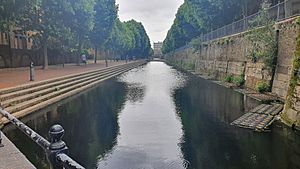London Docks facts for kids
The London Docks were a very important part of the historic Port of London. They were built in an area called Wapping, which is downstream from the City of London. Construction started in 1799 and finished in 1815.
Before these docks, ships usually used wharves along the River Thames. But by the late 1700s, London needed much more space for ships. The London Docks were the closest docks to the City of London for many years. Later, the St Katharine Docks were built nearby.
Contents
Building the London Docks
A group called the London Dock Company was created in 1800. Work on building the docks began the very next year, in 1801. Many years later, in 1864, the London Dock Company joined with the company that ran the St Katharine Docks.
How the Docks Looked
The London Docks covered a large area, about 30 acres (120,000 square meters). They had two main parts: the Western Dock and the Eastern Dock. These two large docks were connected by a smaller area called Tobacco Dock.
The Western Dock had two ways to connect to the River Thames: Hermitage Basin and Wapping Basin. The Eastern Dock connected to the Thames through Shadwell Basin. The main people who designed these docks were Daniel Asher Alexander and John Rennie.
The docks were special because they handled expensive goods. These included things like ivory, spices, coffee, cocoa, wine, and wool. Special warehouses and wine cellars were built to store these valuable items. The docks were never connected to the railway system. In 1909, the Port of London Authority took over the London Docks and other docks in the area.
After the Docks Closed
The London Docks stopped being used by ships in 1969. The land was then sold to the local council, the London Borough of Tower Hamlets. A big part of the Western Dock was filled in. The idea was to build homes there, but this didn't happen right away.
In 1981, a group called the London Docklands Development Corporation (LDDC) took over the land. They started to build new homes and businesses. Over 1,000 new properties were built around the old Tobacco Dock and Shadwell Basin.
A large printing factory for Rupert Murdoch's News International company was built on the northern part of the filled-in Western Dock. Some parts of the old docks, like Hermitage Basin and Shadwell Basin, are still there today. Wapping Basin is now a sports field, and some of the Eastern Dock is open space. A small canal still runs through part of the old Western Dock site.
Images for kids
-
Port wine from Oporto being unloaded at the London Docks around 1909.
See also
- Safeguarded wharf






